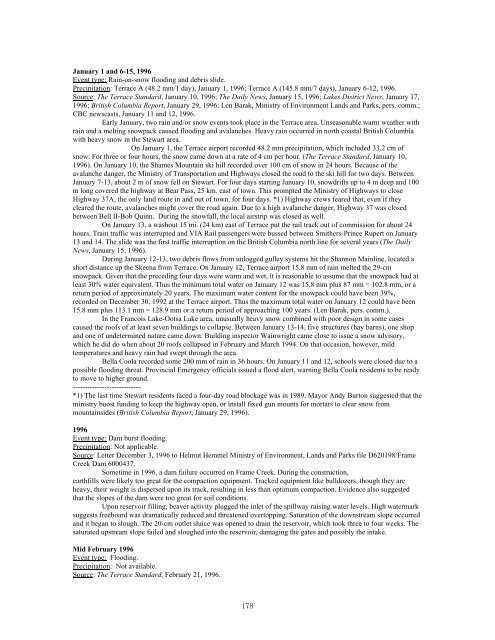HISTORICAL NEWS SEARCH - Government of British Columbia
HISTORICAL NEWS SEARCH - Government of British Columbia
HISTORICAL NEWS SEARCH - Government of British Columbia
Create successful ePaper yourself
Turn your PDF publications into a flip-book with our unique Google optimized e-Paper software.
January 1 and 6-15, 1996<br />
Event type: Rain-on-snow flooding and debris slide.<br />
Precipitation: Terrace A (48.2 mm/1 day), January 1, 1996; Terrace A (145.8 mm/7 days), January 6-12, 1996.<br />
Source: The Terrace Standard, January 10, 1996; The Daily News, January 15, 1996; Lakes District News, January 17,<br />
1996; <strong>British</strong> <strong>Columbia</strong> Report, January 29, 1996; Len Barak, Ministry <strong>of</strong> Environment Lands and Parks, pers. comm.;<br />
CBC newscasts, January 11 and 12, 1996.<br />
Early January, two rain and/or snow events took place in the Terrace area. Unseasonable warm weather with<br />
rain and a melting snowpack caused flooding and avalanches. Heavy rain occurred in north coastal <strong>British</strong> <strong>Columbia</strong><br />
with heavy snow in the Stewart area.<br />
On January 1, the Terrace airport recorded 48.2 mm precipitation, which included 33.2 cm <strong>of</strong><br />
snow. For three or four hours, the snow came down at a rate <strong>of</strong> 4 cm per hour. (The Terrace Standard, January 10,<br />
1996). On January 10, the Shames Mountain ski hill recorded over 100 cm <strong>of</strong> snow in 24 hours. Because <strong>of</strong> the<br />
avalanche danger, the Ministry <strong>of</strong> Transportation and Highways closed the road to the ski hill for two days. Between<br />
January 7-13, about 2 m <strong>of</strong> snow fell on Stewart. For four days starting January 10, snowdrifts up to 4 m deep and 100<br />
m long covered the highway at Bear Pass, 25 km. east <strong>of</strong> town. This prompted the Ministry <strong>of</strong> Highways to close<br />
Highway 37A, the only land route in and out <strong>of</strong> town, for four days. *1) Highway crews feared that, even if they<br />
cleared the route, avalanches might cover the road again. Due to a high avalanche danger, Highway 37 was closed<br />
between Bell II-Bob Quinn. During the snowfall, the local airstrip was closed as well.<br />
On January 13, a washout 15 mi. (24 km) east <strong>of</strong> Terrace put the rail track out <strong>of</strong> commission for about 24<br />
hours. Train traffic was interrupted and VIA Rail passengers were bussed between Smithers-Prince Rupert on January<br />
13 and 14. The slide was the first traffic interruption on the <strong>British</strong> <strong>Columbia</strong> north line for several years (The Daily<br />
News, January 15, 1996).<br />
During January 12-13, two debris flows from unlogged gulley systems hit the Shannon Mainline, located a<br />
short distance up the Skeena from Terrace. On January 12, Terrace airport 15.8 mm <strong>of</strong> rain melted the 29-cm<br />
snowpack. Given that the preceding four days were warm and wet, it is reasonable to assume that the snowpack had at<br />
least 30% water equivalent. Thus the minimum total water on January 12 was 15.8 mm plus 87 mm = 102.8 mm, or a<br />
return period <strong>of</strong> approximately 20 years. The maximum water content for the snowpack could have been 39%,<br />
recorded on December 30, 1992 at the Terrace airport. Thus the maximum total water on January 12 could have been<br />
15.8 mm plus 113.1 mm = 128.9 mm or a return period <strong>of</strong> approaching 100 years. (Len Barak, pers. comm.).<br />
In the Francois Lake-Ootsa Lake area, unusually heavy snow combined with poor design in some cases<br />
caused the ro<strong>of</strong>s <strong>of</strong> at least seven buildings to collapse. Between January 13-14, five structures (hay barns), one shop<br />
and one <strong>of</strong> undetermined nature came down. Building inspector Wainwright came close to issue a snow advisory,<br />
which he did do when about 20 ro<strong>of</strong>s collapsed in February and March 1994. On that occasion, however, mild<br />
temperatures and heavy rain had swept through the area.<br />
Bella Coola recorded some 200 mm <strong>of</strong> rain in 36 hours. On January 11 and 12, schools were closed due to a<br />
possible flooding threat. Provincial Emergency <strong>of</strong>ficials issued a flood alert, warning Bella Coola residents to be ready<br />
to move to higher ground.<br />
----------------------------<br />
*1) The last time Stewart residents faced a four-day road blockage was in 1989. Mayor Andy Burton suggested that the<br />
ministry boost funding to keep the highway open, or install fixed gun mounts for mortars to clear snow from<br />
mountainsides (<strong>British</strong> <strong>Columbia</strong> Report, January 29, 1996).<br />
1996<br />
Event type: Dam burst flooding.<br />
Precipitation: Not applicable.<br />
Source: Letter December 3, 1996 to Helmut Hemmel Ministry <strong>of</strong> Environment, Lands and Parks file D620198/Frame<br />
Creek Dam 6000437.<br />
Sometime in 1996, a dam failure occurred on Frame Creek. During the construction,<br />
earthfills were likely too great for the compaction equipment. Tracked equipment like bulldozers, though they are<br />
heavy, their weight is dispersed upon its track, resulting in less than optimum compaction. Evidence also suggested<br />
that the slopes <strong>of</strong> the dam were too great for soil conditions.<br />
Upon reservoir filling, beaver activity plugged the inlet <strong>of</strong> the spillway raising water levels. High watermark<br />
suggests freeboard was dramatically reduced and threatened overtopping. Saturation <strong>of</strong> the downstream slope occurred<br />
and it began to slough. The 20-cm outlet sluice was opened to drain the reservoir, which took three to four weeks. The<br />
saturated upstream slope failed and sloughed into the reservoir, damaging the gates and possibly the intake.<br />
Mid February 1996<br />
Event type: Flooding.<br />
Precipitation: Not available.<br />
Source: The Terrace Standard, February 21, 1996.<br />
178

















